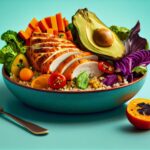Losing weight is not as easy as gaining weight. You have to sweat out your body to shred inches. Food and nutrition field has evolved with time and other advancements. There are specific diets to reduce belly fat.
If you couple a diet that reduces belly fat with some exercises you can get the results faster. Number of diets are available with variation in carb, protein and fats ratio giving the desired results.
All human bodies are not the same, each has different requirements. The best way to opt for a diet is get help from a dietitian or healthcare professional.
Losing weight is always challenging but if you are aiming to shrink your belly fat in 30 days, here are 10 different diets. You can adopt the one that suits you better.
1. The Mediterranean Diet
The Mediterranean diet is an eating pattern that is based on the cuisines of countries bordering the Mediterranean Sea. The diet has gained popularity in recent years due to its many health benefits.
The cornerstone of the Mediterranean diet is fresh, whole foods such as vegetables, fruits, whole grains, and healthy fats. Fish, poultry, and beans are also key components of the diet, and red meat is consumed only occasionally.
One of the defining features of the Mediterranean diet is its emphasis on olive oil. This healthy fat is used in place of butter or other saturated fats, and it has been shown to promote heart health and lower cholesterol levels.
The Mediterranean diet also includes moderate amounts of red wine, which is thought to boost levels of “good” HDL cholesterol. The combination of all these factors makes the Mediterranean diet an incredibly healthy way to eat.
Summary: Mediterranean Diet focuses more on fresh fruits and vegetables, while meat sources are not taken in abundance. Olive oil and beans are main ingredients of this diet
2. The Dukan Diet
The Dukan Diet is a high-protein, low-carbohydrate diet that focuses on lean meats and vegetables. The diet is divided into four phases:
● Phase 1 (the Attack phase) is a protein-only phase
● Phase 2 (the Cruise phase), which allows for limited carbohydrates.
● Phase 3 (the Consolidation phase) reintroduces more carbs and fats, and
● Phase 4 (the Stabilization phase) is the maintenance stage, where dieters can eat
whatever they want while still following the principles of the diet.
The Dukan Diet has been shown to be effective for weight loss, and some studies have even suggested that it can help to reduce the risk of heart disease and Type 2 diabetes.
However, as with any diet, it is important to speak with a doctor before starting the Dukan Diet to make sure it is the right choice for you.
Summary: It is a four-phase high protein showing benefits in weight loss, Heart, and Type 2 Diabetes patients.
3. The Atkins Diet
The Atkins Diet is a popular weight loss plan that was first developed in the 1970s. The diet is based on the premise that eating foods high in carbohydrates can cause weight gain, as the body breaks down carbs into sugar and stores it as fat.
The Atkins Diet prescribes a return to a low-carbohydrate way of eating in order to achieve weight loss. This involves consuming mostly protein and fat, and limiting carbs to less than 20 grams per day.
The Atkins Diet has been shown to be effective for weight loss, and epilepsy; many people find it easy to stick to in the long term.
However, some experts have raised concerns about the potential health risks of following a high-protein diet, such as increased cholesterol levels and kidney damage. As with any weight loss plan, it is important to speak with a doctor before starting the Atkins Diet.
Summary: Atkins diet eliminates carbs from your diet, increasing the protein intake, that can be alarming for the renal patients.
4. The South Beach Diet
The South Beach Diet is a weight-loss plan that emphasizes eating healthy foods, like lean protein, vegetables, and whole grains, and avoiding processed foods, sugary sweets, and bad fats.
The thinking behind the South Beach Diet is that by eating nutrient-rich foods, you’ll not only lose weight, but also improve your overall health.
The South Beach Diet was created by Dr. Arthur Agatston, a cardiologist, in the early 2000s. It’s since become one of the most popular diets in the world, with both a book and website devoted to helping people follow the plan.
While there are some critics of the diet who say it’s too restrictive or that it’s not sustainable in the long-term, many people who have followed the plan report success in losing weight and improving their health.
Whether you’re looking to lose a few pounds or make a major lifestyle change, the South Beach Diet may be worth considering.
Summary: The motto of South Beach Diet is to consume lean meat and other nutrient dense food to improve overall quality of life.
5. The Paleo Diet
The Paleo diet is based on the eating habits of our Stone Age ancestors. The thinking behind it is that, since they were hunter-gatherers, they must have been eating the same foods that we should be eating today.
This means lots of fresh fruits and vegetables, lean meat, and fish. It also means avoiding processed foods, dairy products, and sugar.
Some people who follow the Paleo diet also choose to eat nuts and seeds, while others avoid them due to their high calorie content.
There is no one-size-fits-all approach to the Paleo diet; instead, people are encouraged to tailor their intake to their own individual needs. For example, someone who is very active might need to eat more calories than someone who is sedentary.
The bottom line is that the Paleo diet is a healthy way to eat that can provide you with all the nutrients you need.
Summary: Paleo Diet has a tailored approach and emphasis on the foods our ancestors eat.
6. The Zone Diet
The Zone diet is a popular eating plan that was created by biochemist Barry Sears in the 1990s. The diet is based on the theory that balancing the intake of certain nutrients – namely, carbohydrates, proteins and fats – can help to promote health and wellness.
The Zone diet typically involves eating three meals and two snacks per day, and each meal should consist of approximately 30% carbohydrates, 30% protein and 40% fat.
The diet also recommends consuming a specific ratio of omega-3 to omega-6 fatty acids, which is thought to promote inflammation.
Though the Zone diet has been shown to be effective for weight loss and reducing inflammation in athletes, it is important to note that it may not be suitable for everyone. Consult with a healthcare professional before making any major changes to your diet.
Summary: The Zone diet has a fixed ratio of carbs, protein and fats (30:30:40). Due to high fat ratio, it is a good anti-inflammatory diet.
7. The Keto Diet
The Keto diet is a high-fat, moderate-protein, and low-carbohydrate diet that has been used for centuries to treat various medical conditions.
The diet is based on the premise that by drastically reducing carbohydrate intake, the body will be forced to burn fat for fuel.
This process, known as ketosis, is thought to lead to a variety of health benefits, including weight loss, improved mental clarity, and reduced inflammation.
While the Keto diet is often recommended by medical professionals as a therapeutic option for certain patients, it has also become popular among those looking to improve their overall health and well-being.
Whether you are seeking medical guidance or simply wanting to make some healthy lifestyle changes, the Keto diet may be worth considering.
Summary: Keto diet not only benefits in weight loss but it also improves other medical conditions like epilepsy and cancer.
8. The Vegetarian Diet
Though there are many different types of vegetarians, all vegetarians have one thing in common: they do not eat meat.
The vegetarian diet is based on plants, including vegetables, fruits, grains, nuts, and seeds. Some vegetarians also eat eggs and dairy products, but avoid eating animals that have been killed.
The vegetarian diet has many benefits. Studies have shown that vegetarians tend to be healthier than people who eat meat, with lower rates of heart disease, cancer, and obesity.
In addition, the vegetarian diet is more environmentally sustainable than a meat-based diet, as it requires less land, water, and energy to produce. For these reasons and more, the vegetarian diet is becoming increasingly popular around the world.
Summary: Vegetarian Diet focuses on plant based food sources and is favorable for cardiac and cancer patients.
9. The DASH Diet
The DASH diet is a popular eating plan that emphasizes fruits, vegetables, whole grains, and low-fat dairy products.
The letters “DASH” stand for Dietary Approaches to Stop Hypertension, and the diet was originally designed to help people lower their blood pressure.
However, the DASH diet has also been shown to be effective in reducing the risk of heart disease, stroke, and other chronic conditions.
The key to the DASH diet’s success is its focus on healthy foods that are rich in nutrients and fiber but low in calories and saturated fat. By following the DASH diet, you can improve your overall health and fitness while also losing weight quickly.
Summary: This diet is best for hypertensive patients as it limits your salt intake and tends towards healthier food options.
10. The Slimming World Diet
The swimming world diet is a nutritional program designed specifically for competitive swimmers. The diet is based on the premise that swimming is a highly demanding sport that places unique nutritional requirements on athletes.
The diet focuses on providing swimmers with the nutrients they need to perform at their best, while also helping them to maintain a healthy weight.
The swimming world diet includes plenty of lean protein, healthy fats, and complex carbohydrates.
These nutrients are essential for building muscle, reducing body fat, and improving endurance. In addition, the diet also provides ample hydration, which is key for maintaining optimal performance in the pool.
While the swimming world diet may be demanding, it is an effective way for competitive swimmers to meet their nutritional needs and improve their performance in the pool.
Summary: It comprises high protein (lean), good fats and complex carbs to deal with the nutritional needs of the swimmers.
Also Read: Should You Start Intermittent Fasting?
Conclusion
If you’ve ever been on a diet, you know the drill: cut back on calories, hit the gym hard, and watch the pounds melt away. But is this the best approach to weight loss?
Some experts say no. They argue that crash diets can lead to yo-yo dieting, which can be both physically and mentally harmful.
Instead of trying to lose weight quickly, they recommend a more gradual approach. This may not sound as exciting, but it can be more sustainable in the long run.
Slower weight loss also has some other benefits. It can help you to preserve muscle mass, which is essential for maintaining a healthy metabolism.
It can also help to prevent rebound weight gain, which often happens when people lose weight too quickly. So if you’re considering starting a weight-loss journey, take some time to think about the best approach for you.
There’s no one-size-fits-all solution, but slow and steady may just be the best way to achieve your goals.






